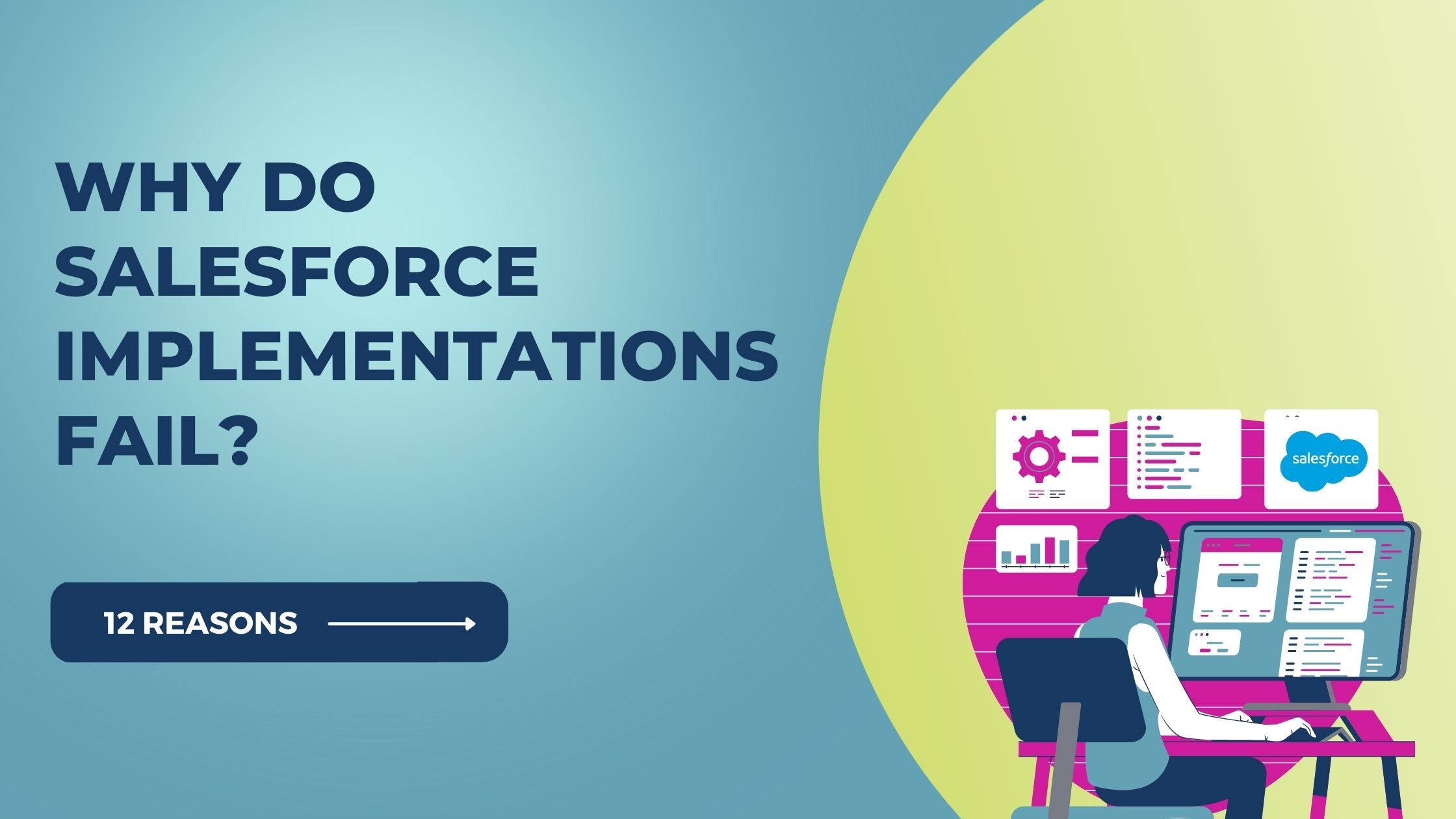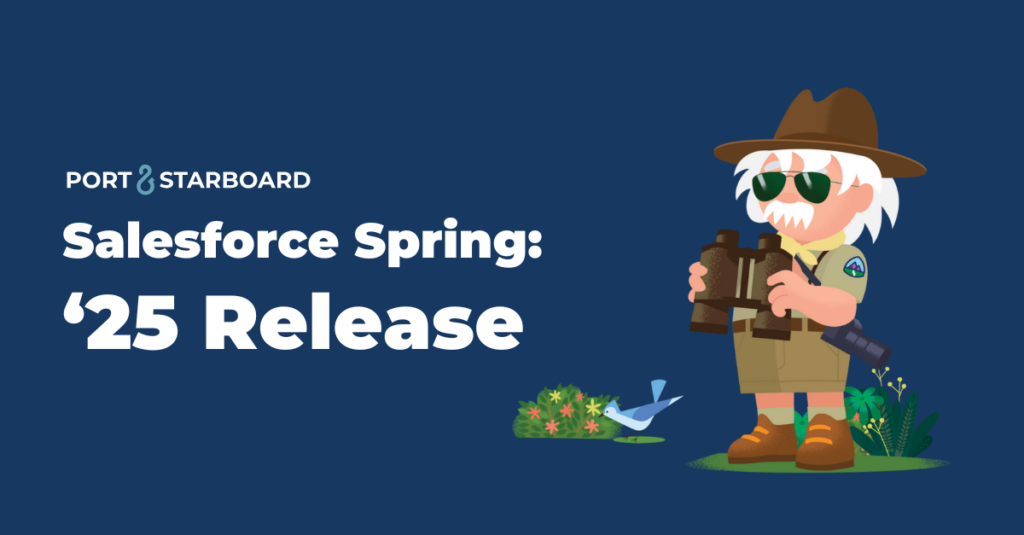Did you know that up to 70% of all CRM projects fail? This may sound discouraging if you’re planning on implementing a CRM tool like Salesforce for the first time. But the thing about failure is we can learn from it. We’re about to tackle the top reasons for implementation failure – and how to avoid every one of them.
Salesforce is a powerful tool that offers a high return on investment if properly implemented. Dynamic Consultants Group calculates the ROI today to be approximately $30.48 for every dollar spent. (You can predict your ROI using the Salesforce ROI tool).
Below, we break down the reasons Salesforce implementations fail into three categories: planning, technology, and user experience. Establish a strong foundation for your CRM and business operations by avoiding these common pitfalls.
12 Common Reasons Salesforce Implementations Fail
PLANNING:
1. Unclear Goals
Why are you purchasing Salesforce in the first place? Is it mainly because other businesses in your field have already implemented it, or because you have concrete goals you want to accomplish?
If you want your Salesforce implementation to be successful, you need a clear vision, goals, and strategies to reach them. This requires careful planning and clear, open communication with everyone involved in the project.
Decide which pain points you want to address, how the CRM can streamline your workflows, and how it will improve the customer experience. Make sure your goals are specific, measurable, attainable, relevant, and time-bound (SMART). That way, you’ll know what to focus on, how to measure your progress, and when you’ve succeeded.
2. Confusing CRM Business Strategies
Vague or conflicting CRM business strategies can cause confusion and distract from the goals you’ve identified for your implementation. Establishing a clear and concise business strategy is a great way to start your implementation off on the right foot. Once you’ve established clear goals, you can develop a roadmap that will empower you to reach them. This should be a company-wide initiative. If properly implemented, Salesforce will impact your entire organization – including your employees and customers.
Ultimately, Salesforce is about people and relationships. Involving all stakeholders and listening to suggestions will help you create a more holistic strategy and facilitate a successful adoption. It will also improve the customer journey, leading to higher sales and ongoing customer satisfaction.
3. Lack of Executive Support
Gaining executive support is critical for Salesforce implementations to be successful. Senior management must share your vision for what you plan to accomplish by adopting Salesforce. Getting executives involved from the beginning will:
- Allow them to provide direction,
- Help you align the project with overarching business strategies, and
- Help you gain buy-in from other top management players.
Appoint an executive sponsor, such as your CEO, who understands the importance of Salesforce for your organization and will commit to your project to ensure complete adoption.
4. Insufficient Budget
Some Salesforce implementations fail because organizations don’t budget enough money upfront. Sometimes this is unavoidable. Businesses can’t always predict every functionality they will need from the start. Some companies implement the simplest form of Salesforce as they learn the ropes. There’s nothing wrong with either of these options.
Be open about your expectations to avoid under-budgeting or overpromising to executive teams and stakeholders. When setting your budget, be as realistic as possible, stay focused on your goals, and anticipate scope change. Including a ten percent buffer in your budget can help account for any surprises that come up along the way. Also consider how your Salesforce implementation will affect employee schedules and their workloads. Continuously forecast and update your budget accordingly, keeping everyone updated with where your project is heading.
5. Inaccurate Data
Salesforce implementations can also fail due to fundamental data problems. If your data is incomplete, inaccurate, or duplicative, it could lead to a myriad of problems:
- Poor customer experience
- Incorrect budget and revenue forecasting
- Misguided business strategies
- Distrust
End users, executive sponsors, and Salesforce administrators must all be involved in keeping your data clean and organized. Salesforce makes it easy to define new objects and fields, but be mindful of the way you’re collecting data (like using the fewest amount of fields to collect the data you need and prioritizing fields with drop-down values instead of open text fields) to avoid long data input forms, poor reporting, unsatisfied user adoption, and an inability to scale.
To avoid this mess, keep your data entry process as simple as possible for users. Clearly define required fields, allow auto-population, and enforce validation rules to ensure correct entry. If your current data is “dirty,” you’ll need to clean it up before moving to Salesforce.
TECHNOLOGY:
6. Prioritizing Technology Over People
Another pitfall businesses face is prioritizing technology or products over the people using them. Shifting your focus to the customer or end-user can help you avoid CRM failure. Your end-users should be at the very heart of your business mission and goals.
Salesforce implementations aren’t technology projects. They’re people projects, so make your employees and customers the focus. Give them a voice, keep them informed of changes, and use their feedback to improve your technology. Ensure your plans and processes support the end-user experience.
PwC is known for its highly successful Salesforce rollout across its global network spanning 158 countries. The secret ingredient? Putting people at the center of the journey.
7. Misalignment with Current IT Architecture
Often, Salesforce CRM implementation plans don’t consider existing IT frameworks. Your current IT infrastructure has likely been carefully planned and implemented, so your Salesforce adoption must align with it.
Ensure your IT team understands your strategy to integrate the new system with the current system. This alignment can facilitate faster time-to-market, enhance the customer experience, improve agility, and increase profitability.
8. An Inexperienced Support Team
Some businesses learn the basics of how Salesforce works and then attempt to configure it themselves. However, this often leads to bottlenecks, slowed productivity, and an inability to scale – all events you’re trying to avoid by implementing Salesforce in the first place. Endeavoring to grow after an implementation that does not include a quality support team from the start can kick off a dangerous cycle of requiring rebuilding what’s already configured, which can cause other components to break.
Hiring an experienced Salesforce support team can help you implement the platform using best practices. Your support team should be highly skilled, solve complex problems that arise, and notify you of necessary upgrades along the way – enabling you to scale.
USER EXPERIENCE:
9. Failure to Involve End Users
Most digital transformations fail to generate positive revenue. Did you know that 70% of the time this is due to a lack of user adoption?
Your end goal should be to make your end users’ lives easier. The best way to do that effectively is to involve them throughout the process.
- Let them know what’s coming and why.
- Ask them questions and get their buy-in during the initial stages to learn what they think would make a great CRM system.
- Address pain points specifically around the user experience and interface.
- Show them how valuable the tool will be by building it around their needs.
- Make people want to be involved in the change you’re making so they can’t wait to participate.
This will give users a sense of ownership and can be a game-changer when rolling out Salesforce.
10. Lack of Proper Training
No matter how impressive your new Salesforce CRM platform is, it could prove useless if you don’t adequately train users in how to use it to its full potential. Salesforce is a complex system that requires proper training to integrate successfully. Users must know why they’re implementing the system and how it can benefit them and their work.
11. Poor Communication
Having an implementation team isolated from other groups and stakeholders is a recipe for disaster. Make sure you understand the needs of every key player in your organization. Involve end-users (like we mentioned already) so they have input on the tool they are about to adopt and use regularly.
In every stage of your process, keep communication lines open for discussion. Touch base with teams regularly, and ensure your project continues to meet expectations.
12. Failure to Adopt After Implementation
Let’s bring everything full circle. Salesforce implementations are disruptive – and they should be. They force businesses to make some significant changes. Your data drives critical decisions and impacts everyone throughout your organization. To avoid pushback (or end-users refusing to use the CRM system), everyone must participate in making the integration a success.
If you follow the advice throughout this guide, you can avoid the problems that lead to Salesforce implementation failure. Remember to address challenges along the way (like lack of commitment or buy-in) and encourage full adoption by communicating the value for everyone involved.
How to Ensure Successful Salesforce Implementations
Here’s a quick recap of how to best avoid implementation failure and ensure CRM success for many years to come:
- Set SMART goals.
- Establish a clear strategy for your business CRM implementation.
- Get executive support.
- Set a realistic budget.
- Clean your data (and keep it clean).
- Prioritize people over technology.
- Align your new CRM technology integration with existing IT architecture.
- Hire an experienced support team.
- Involve end-users from the beginning.
- Train all users properly.
- Keep communication lines open.
- Fully adopt Salesforce after implementation.
Get the Salesforce Support You Need
Whether you need help implementing Salesforce for the first time or require training and ongoing support for your current system, we’re here to ensure smooth sailing!
Port & Starboard can configure your Salesforce solution to meet your leaders’ expectations and user needs. We can help you choose the best edition for your business, help with process design and mapping, and provide rollout training and support.




